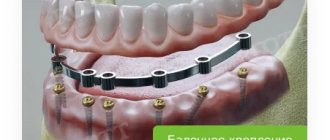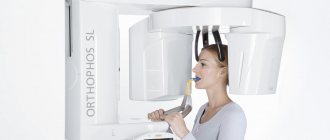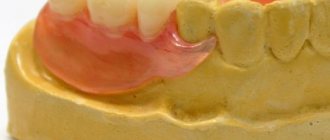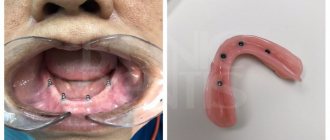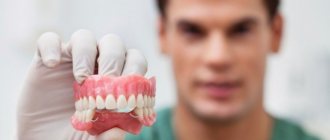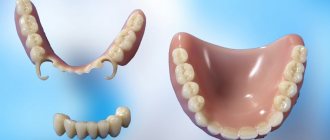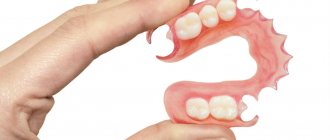Chief editor of the site:
Snitkovsky Arkady Alexandrovich
Chief physician of the professorial dentistry “22 Century”, dentist, orthopedic dentist
Author of the article:
Scientific team of dentistry “22 Century”
Dentists, candidates and doctors of medical sciences, professors
Dentures on implants allow not only to achieve a good aesthetic effect, but also completely restore chewing function
Implant prosthetics is an innovative way to restore teeth. Dentures on implants not only allow you to achieve a good aesthetic effect, but also completely restore chewing function . An implant is the only prosthesis that functions in the same way as a living tooth and can withstand significant chewing loads.
What is implant prosthetics?
There are many methods for restoring teeth in dentistry.
Each of them has its advantages and helps solve a specific problem. However, implant prosthetics are considered the most effective. The basis of the method is the implantation of titanium pins into the jawbone, which replace the roots of natural teeth. An orthopedic structure is installed on top of the pin, depending on the condition of the dentition.
The technology is applicable to restore one tooth, several dental units in a row, or the entire jaw at once. In the first case, an artificial crown is fixed on the implant, a bridge structure is used to replace 2-3 teeth, and when all teeth are restored, a fixed or removable prosthesis is used. The doctor selects the material for the orthopedic design based on the method of installing the prosthesis, the preferences and financial capabilities of the patient.
Types of prosthetics:
- Classic dental implantation. Suitable for cases where 1-2 teeth from a row are missing. Can be with delayed or immediate loading, with installation in one or more stages.
- All teeth in 1 day. It is used in cases of complete edentia (loss of teeth). Offers several solutions, depending on the structure of the jaw and the condition of the bone tissue. This can be the installation of All-on-4, All-on-6 protocols or simultaneous implantation.
Pros of technology
Some will say that dental implantation is very expensive. But if you evaluate the result in perspective, it turns out that this is a profitable investment in your own health for the next 20-25 years.
Judge for yourself: the service life of prostheses on implants is 2-3 times longer than traditional designs. And the titanium pin ensures an even load on the jaw, while maintaining chewing and speech functions.
In addition, the use of implants when installing dentures allows you to restore any number of teeth, regardless of their location in the oral cavity.
In case of edentia (complete absence of teeth), implants can be used to place not only a removable, but also a permanent orthopedic structure, which in its properties is much more convenient and reliable.
An even load on the upper and lower jaw eliminates bone tissue atrophy and subsequent problems with natural teeth. In addition, implant prosthetics do not use healthy teeth. Nothing is attached to them; natural teeth do not need to be ground down, which significantly extends their life.
Dentures are comfortable to wear: they do not injure the gums, do not distort diction, and do not shift under load.
But the main advantage is the high level of aesthetics. All types of dentures installed on implants look like real teeth.
Types of prostheses on implants
In general, implant-supported prostheses are divided into two types:
- Removable.
- Fixed.
The first type differs significantly from analogues of classical prosthetics. Traditional structures are fixed exclusively on the gums, or attached to supporting teeth. Thanks to implants, removable dentures are securely fixed in the jawbone, but they can be removed if necessary. That's why they are called conditionally removable.
Fixed dentures are considered a more durable and optimal option for dental restoration. In addition to the artificial crown, some types of structures are equipped with a base made of elastic plastic, which imitates natural gums.
Fixed dentures can be used to replace any number of teeth, even if they are located in different parts of the dentition. We will talk in more detail about each type of prosthesis a little later.
There are also temporary dentures that are installed during the period of fusion of the implants with the jawbone. They maintain the aesthetics of the dentition and reduce the mechanical load on the pins, speeding up the healing process.
Temporary dentures look like removable structures that hook onto supporting healthy teeth using hooks. The most common option is a butterfly-shaped prosthesis. It is equipped with a plastic gum and two plastic holders for adjacent teeth. A denture replaces one or more teeth in a row.
Swiss implants from the Straumann brand (Straumann)
Swiss Straumann implants are considered luxury solutions. In terms of their price category, the systems are approximately at the same level as Nobel Biocare and Astra Tech (these two brands are considered American, but are produced in Switzerland). The Straumann company was born in the mid-1950s. It is interesting that initially metal structures were produced under this brand, and a little later the company chose a new dental vector in development - dental implants. It was the Swiss brand Straumann that came up with the idea of developing a one-component implant, which is combined with an abutment.
It is important!
According to international statistics, about 20% of the global implant market is accounted for by Swiss implants from the Straumann brand. More than ten million implants have been installed around the world, which have helped people restore their teeth and enjoy a healthy and beautiful smile.
TOP 5 advantages of Swiss implants from the Straumann brand (Switzerland):
- Innovative SLActive surface. Thanks to special etching of the metal with acid, a surface unique in its biological properties is created. As a result, such an implant made in Switzerland takes root well in the bone tissue, and prosthetics can be prescribed literally within a month.
- Unique material "Roxolid". It is an alloy of titanium and zirconium. A Swiss implant made from this material is characterized by better biocompatibility and increased strength. Implants of this type are much smaller in size than analogues from competing brands.
- Metal-free ceramics from Straumann (Straumann). Ceramic implants from Switzerland are a real revolution for people with allergies to metal alloys. Such implants are often placed in the smile area because they are light in color and are not visible through the soft tissue.
- Impressive system adoption statistics. On average, about 99.6% of dental implants from the Swiss brand Straumann successfully take root.
- Large selection of systems for any clinical case. The model range of the Swiss brand Straumann includes implants that are completely immersed in the bone, without a polished neck, and other options.
The estimated price of the Straumann product in Moscow clinics is from 45,500 rubles. When installing a Swiss implant with a crown, turnkey work will cost about 65,000 rubles for one product.
Three series of dental implants from the Straumann brand:
- Tissue Level implants are adapted for classical and one-stage implantation. Thanks to the specially shaped cervical area, they help to significantly reduce the period of formation of the gum contour;
- Bone Level are Swiss implants of a universal type in the shape of a cone. Such systems allow you to achieve impeccable aesthetics in the gum area, and are especially suitable for restoring the smile area;
- Pure are metal-free implants made of ultra-strong ceramics. Optimal for patients with an allergy to metal, anatomically thinned gums, through which a conventional metal implant will be visible.
Installation steps
The reliability of implant-supported dentures directly depends on the location of fixation. Especially when it comes to restoring all teeth. Correct placement of implants will ensure uniform distribution of chewing load on the jaw and allow the use of a minimum number of pins. This reduces the recovery period and the degree of surgical intervention during installation.
At the initial stage, the implantologist performs an initial examination of the oral cavity. In EspaDent clinics, to select a prosthetic method, additional diagnostics are carried out using a modern Orthophos SL 3D tomograph, which takes three-dimensional, layer-by-layer images of both jaws. Professional equipment allows you to simulate the treatment process and show the patient the final result.
In the absence of contraindications, the doctor proceeds to the next stage of prosthetics on implants - fixation of titanium pins in the jawbone. The procedure takes 40-60 minutes for each implant. It is carried out using anesthesia. Our specialists use safe painkillers. They are non-toxic and do not cause allergic reactions.
The pin fixation process includes:
- Gum section.
- Preparing the space in the jawbone.
- Implant installation.
- Gum stitching.
The period of fusion of the pin with the bone tissue takes 3-4 months. During this time, the patient is fitted with temporary removable dentures, which we discussed above.
After the healing process is completed, the doctor installs a gum former and takes an impression of the teeth. After a couple of days, the adapter is replaced with an abutment, on which the finished denture is fixed.
Price
- Primary appointment (examination, consultation) with a dentist (special offer) 100001
For free
Promotion
- Drawing up a preliminary treatment plan without visiting 100020
For free
- Dental prosthetics using implants Acrylic covering prosthesis with a cast frame made of CoCr alloy (excluding the cost of fixing elements: locators, spherical abutments) 154001
60 000 ₽
- Dental prosthetics using implants Acrylic screw-fixed prosthesis with a cast frame made of CoCr alloy (excluding the cost of fixing elements: uniabutments) 154002
99 000 ₽
- Dental prosthetics using implants Bar prosthesis with a cast frame made of CoCr alloy (excluding the cost of fixing elements: uniabutments) 154004
179 000 ₽
- Dental prosthetics using an SGS implant with a metal-ceramic crown (special offer) 300001
5 000 ₽
Promotion
- Dental prosthetics using an all-zirconium crown implant (special offer) 300002
10 000 ₽
Promotion
- Prosthetics of all jaw teeth on 4 implants
149 900 ₽
Promotion
Implant prosthetics is a modern way to restore lost teeth. With the help of implants, you can restore individual units or the entire dentition. Implantation of an artificial rod allows you to create the necessary load on the jaw and prevent atrophic changes. Artificial teeth completely replace natural teeth, both in an aesthetic and functional sense. The service life and cost of dental prostheses depend on the type of structure, the extent of the defect, and the technology chosen. The implants themselves last a lifetime with proper care.
How long does implant prosthetics take?
The duration of installation of prostheses on implants depends on the clinical situation. After performing a tomography of the jaw, the doctor assesses the condition of the bone tissue. Depending on the degree of jawbone atrophy, the implantologist may prescribe an osteoplasty procedure.
The period of prosthetics on implants is determined by the rate of bone tissue regeneration, as well as the chosen installation technique. For example, the healing period of implants in the upper jaw takes, on average, 3-4 months. For the lower jaw a little less - 2-3 months.
If a procedure is carried out to restore bone tissue due to atrophy, then another 2-4 weeks are added to the installation of prostheses.
Bar prosthesis on implants –
Covering dentures on implants in the absence of teeth can have not only a push-button type of fixation. In this case, the prosthesis can be fixed on a metal beam secured to 2-4 implants. A recess will be made in the plastic base of the removable denture (corresponding to the size and shape of the metal beam), and silicone holders will be inserted there.
Beam prosthesis on implants: photo
Important: in the upper jaw, only 4 implants should always be installed under the bar structure. This is due to the softer bone of the upper jaw and the high risk of rejection of only 2 implants due to their overload, as well as the fact that the denture on the crown beam will simply balance on it (24stoma.ru). Installing exactly 4 implants will not only extend the durability of the entire structure, but will also significantly increase the stability of the prosthesis and its chewing efficiency.
On the lower jaw, you can make a beam supported by 3 or 4 implants, but the latter option will also be more reliable. Some doctors, seeing that the patient cannot afford to make a prosthesis with this type of fixation on 3-4 implants, make a beam on only 2 implants (installed in the anterior part of the jaw). This, as expected, leads to poor stability of the prosthesis, severe bone atrophy in the lateral parts of the jaw, a high risk of overloading the implants and a low service life of the entire structure.
Important: if you agree to this type of fixation, then the technological method for manufacturing the metal beam will be a very important point. It can be made by casting, welded (welded) from several fragments, or made by milling using CAD/CAM. Ideally, the beam was made using the latter method. And it is especially important that impressions are taken only using the “open impression tray” method (this will ensure accuracy).
Advantages of the beam type of fixation -
- higher chewing efficiency,
- higher stability of the prosthesis,
- Maintenance of the prosthesis fastening system by the dentist is almost not required,
- less risk of implant overload,
- longer service life of the structure.
Disadvantages of the beam type of fixation -
- technically very complex production,
- very high cost,
- higher risk of developing inflammation around implants (due to the need for more careful hygiene),
- you cannot use an old prosthesis,
- if the beam is made on only 2 implants – poor stability of the prosthesis + severe bone atrophy in the lateral parts of the jaws.
Prosthetics using removable structures
When is it advisable to use removable dentures on implants? Often the argument is limited budget. Removable structures are much cheaper than permanent ones, especially in the case of complete edentia.
The method is effective for severe atrophy of the jaw bone, if the patient is not ready to undergo a sinus lift of the jaw. A denture with artificial gum will hide imperfections in the contour of your own tissues.
Conditionally removable structures are fixed to implants in two ways: screw or beam. In the second case, a metal structure in the form of a beam is used, on which artificial teeth are installed. The beam serves as the base of the prosthesis and ensures uniform distribution of mechanical load on the bone. Due to the single design, the prosthesis is more stable.
Both options for fixing the prosthesis can be removed if necessary (for cleaning, etc.). However, only a dentist should do this.
What is the difference between classic removable dentures and those installed on implants? The design with pins is smaller in size and has better fixation in the oral cavity, which ensures comfortable wearing.
The absence of a palate in the prosthesis preserves taste sensitivity when eating food, without any restrictions.
The ability to remove the prosthesis extends its service life and allows for timely cleaning and replacement of elements, if necessary.
Lower cost makes this type of implant prosthetics accessible to most patients.
If we talk about size, fixed dentures are more neat and compact. From an aesthetic point of view, removable ones are also inferior to non-removable ones. The latter do not have artificial gums.
To make crowns in removable dentures, the following is used:
- Plastic (for temporary fixation).
- Ceramics.
- Zirconium dioxide.
All materials have increased strength and high aesthetics. At EspaDent clinics, crowns are made using digital CAD/CAM technology. The automatic production mode eliminates the occurrence of errors associated with the human factor. Dentures take into account the anatomical structure of the patient’s jaw and the location of adjacent teeth. Their installation does not change the bite, does not deform the masticatory muscles, and does not cause facial asymmetry.
Rating of the best dental implants by brand
The rating is based on systems common in the Russian Federation. Compiled taking into account research, opinions of patients and implantologists. It is difficult to determine the best brand, since many are equal in quality characteristics and price.
Premium implants
World-famous manufacturers have long been known and are engaged in their own developments. They belong to the premium segment due to their quality, high survival rate, shortened osseointegration time, and the ability to be used in difficult clinical situations. The only negative that makes patients think is the high cost.
Nobel Biocare is an American brand that occupies 40% of the world market. The company was the first to develop a titanium root and perform dental implant surgery. The manufacturer has a research base, develops new technologies, provides proprietary software, scanning, production, and modeling systems. The line is represented by a wide range of models, with a lifetime manufacturer’s warranty.
Astra Tech is a Swedish brand that is as well known as the first one. The first to propose the use of a conical connection between the abutment and the implant to reduce bone resorption around the neck of the artificial root. They produce high quality implants with a lifetime guarantee.
Straumann is a Swiss brand with high quality and world renown. Patented technology with a porous structure close to natural bone increases the speed of engraftment. A lifetime warranty is provided. Among the company's developments are aesthetic implants made of zirconium dioxide.
Middle class
The systems belong to the middle segment; their characteristics are close to premium ones, but they are inferior in terms of survival rates and osseointegration periods.
Impro is a German brand of universal artificial roots that can withstand loads of up to 100 kg. Developed on the basis of Astra Tech. Suitable for all protocols in medium-density bone, take 3 months to survive.
Xive Ankylos is a German brand with a special thread and a patented porous surface of titanium roots. Engraftment is accelerated by 1.5-2 times, the implant is stable and does not cause injury. The set comes with surgical instruments.
Biohorizons is an American brand with decent quality. The manufacturer has a research center and its own developments. The technology used with microchannels on the neck of the implant and the special surface reduce the time of osseointegration. At the same time, the price is affordable.
Budget systems
Manufacturers produce fairly high-quality implants, but do not have extensive solutions for implantation in difficult cases. Budget implants are almost half the price of premium ones, which attracts patients.
Osstem is a South Korean brand. In the domestic market they position themselves as a premium class, competing with Israeli implants. In Russia, annual training and advanced training courses for implantologists are held. The line of implants is developed based on Straumann.
Alpha Bio is an Israeli brand popular in Russia. Astra Tech and Nobel technologies are used. Assortment for different clinical cases. Artificial roots with a proprietary micro-rough surface.
Dentium is a South Korean brand with root-shaped implants of budget and premium classes. They are reliable and aesthetic, easily embedded into the bone, double thread reduces screw-in time. Developed based on Astra Tech. Artificial roots take root quickly, and the abutments do not show through the gums.
Fixed structures
As a rule, crowns or bridges are used for permanent dental prosthetics on implants. A single denture most accurately replicates the shape and appearance of the missing tooth. Using single crowns, the implantologist corrects the gum contour, making it almost ideal. This is especially true for the front teeth that fall into the smile zone.
A bridge structure is used to restore several teeth. It is necessary in cases where it is not possible to install 2-3 implants in a row due to lack of space.
The difference from a traditional bridge lies in the method of fastening. The structure receives additional support in the form of pins and does not affect adjacent healthy teeth. In other words, there is no need to grind down your natural teeth and attach a prosthesis to them.
The advantages of the technique include the maximum degree of stabilization of the prosthesis, high aesthetics and a tight fit of the structure to the gum, which eliminates its damage and the ingress of food debris into the prosthesis.
The only disadvantage of fixed dentures on implants is the price. But in fact, this is the most profitable investment in your own health. The durability of the implants and the lifetime guarantee for their installation only confirms the quality of the technique.
Restoration of teeth with complete edentia
The method of fixed prosthetics effectively copes with the problem of complete absence of teeth. For example, All-on-4, All-on-6 protocols or simultaneous implantation.
The All-on-4 protocol involves the installation of four implants in the jaw: two in the frontal part, two on the sides, at an angle of 45 degrees.
The technology provides instant chewing load, immediately after fixing the prosthesis. Installation of the prosthesis is possible immediately after implantation.
If the patient has severe jawbone atrophy, the All-on-6 protocol is used. An additional number of implants ensures reliable fixation of the prosthesis even with insufficient bone tissue.
But be careful! Due to the popularity of the technology, many fakes have appeared. Poor quality materials and unprofessional work can lead to serious health complications and loss of money.
EspaDent is an official partner of Nobel Biocare, a leader in implantology and developer of protocols for dental restoration in 1 day.
In 2016, with the support of Nobel Biocare, our clinic created its own Center for implantation and complete dental prosthetics, which provides training to specialists from all regions of Russia.
Permanent prosthetics All-on-4 – price and options
All-on-4 permanent dentures can be achieved with different types of permanent fixed dentures. There are a lot of options for permanent prostheses for All-on-4, and it is very difficult for an ordinary patient to understand all their subtleties and nuances. In addition, the choice of prosthesis is determined not only by your aesthetic requirements or financial capabilities, because... In a number of clinical situations, some types of prostheses simply cannot be manufactured.
In addition to the patient’s wishes, the choice of prosthesis will depend on the volume of space for prosthetics (the degree of vertical atrophy of the jaw bone tissue), as well as on the characteristics of the relationship between the upper and lower jaws. For a permanent fixed denture on 4 implants, the price in Moscow and Russia as a whole starts from 150,000 rubles, and this will be the most modest and not very reliable option for a permanent denture. It should be noted that in Russia, in order to reduce the cost of All-on-4, a number of clinics use materials and technologies that have long been abandoned in Europe due to their poor reliability.
Permanent denture options for All-on-4 –
We have already said several times that the All-on-4 technique was developed by Nobel-Biocare (Switzerland), including special types of implants and options for temporary and permanent dentures. In this section, we will first talk about the original options for permanent prosthetics that were developed by Nobel-Biocare, and then move on to a variety of options for prostheses (including non-original economy-class solutions specifically for Russia).
All types of original permanent fixed prostheses for All-on-4 can be divided into two large groups.
- Titanium-polymer prostheses - 90% of permanent prostheses for All-on-4 are made using this technology. Such a prosthesis has a supporting frame inside in the form of a titanium beam, individually manufactured for each patient - by milling on a computer-controlled machine (CAD/CAM technology). The outside of the beam is lined with acrylic plastic or ceramic composite, from which the base of the prosthesis (artificial gum) will be made + artificial teeth will be installed in the base of the prosthesis (Fig. 16-17).
If you are focused on quality, then it is better to choose original solutions - these are only titanium beams from Nobel-Procera, although non-original beams from other manufacturers can also be used (they will be a little cheaper). Modern beams are not made smooth - they have retention projections that act as supports for artificial teeth. The best option is probably the “NobelProcera hybrid beam”, which has no analogues from any company, not even Straumann.
But! Titanium-polymer prostheses require a lot of vertical space for prosthetics, and therefore, if the patient has only a slight degree of atrophy of the jaw bone tissue, these prostheses simply cannot be manufactured. In this case, we will offer the patient only bridges made of zirconium dioxide or metal ceramics.
- Bridges can be the familiar metal-ceramics or metal-free ceramics (zirconium dioxide). In both cases, the bridge frames will also be manufactured by milling using CAD/CAM technology. The original frame for a metal-ceramic bridge is made of titanium, the artificial teeth will be made of zirconium dioxide, and if artificial pink gum is needed, it will be made by applying a ceramic mass (Fig. 18).
The frame of the ceramic bridge will be made of zirconium dioxide, the artificial teeth will also be made of zirconium dioxide + if necessary, the prosthesis can also have pink artificial gum made of ceramic (Fig. 19). This is the best option for a prosthesis in terms of aesthetics, and in the photo below you can see how accurately it imitates the gums and teeth on the lower jaw, which are difficult to distinguish from real ones (Fig. 20).
Important: original All-on-4 prosthetics involves the use of only Nobel-Procera titanium bars and bridges. But it won’t be a problem if your clinic uses non-original milled frames made on similar equipment from other companies. But what’s really bad is when Russian dental clinics offer economical options for prosthetics, for example, when instead of a milled titanium beam, a cast beam made of nickel-chrome alloy is used. Or when metal-ceramics are made on a frame made of cobalt-chromium alloy (CHS), even by milling.
Such solutions make it possible to reduce the cost of All-on-4, but this reduces the strength of the prosthesis frame by at least 5 times, and in addition, the use of cast beams greatly impairs the accuracy of their fit on the installed implants. Another disadvantage is that cast nickel-chrome beams and CCS frames have a significantly greater mass (compared to titanium), which significantly increases the weight of the prosthesis and makes it difficult to get used to it.
Materials for dentures
To attach prostheses to implants, the material must be highly durable or have a metal base. This is necessary for the structure to withstand the load of the abutment (adapter).
Crowns for fixed structures are made from metal-ceramics, composite, metal-plastic, and also from zirconium dioxide. The prosthesis is attached using cement or screws.
Composite crowns for implants with a metal frame are used for single replacements, as well as for the installation of bridges. The design has a long service life (10-12 years) and is subject to repair. Reliable, lightweight, with a high degree of aesthetics, composite crowns are comfortable to wear and look like real teeth.
Plastic removable dentures last no more than 5 years and are used only for temporary or adaptive prosthetics. At EspaDent clinics, our specialists use more technologically advanced plastic for temporary prostheses. The composition contains crushed diamond chips, which makes the structure more resistant to stress during the fusion of the implant with the bone.
Fixed prosthesis is made of zirconium or metal ceramics. This is due to the high reliability of the design. Crowns for implants cannot be restored, as is the case with composite ones, so they must be as strong and durable as possible. For metal-ceramics, the service life is 8-10 years, and zirconium is a little longer - 15-17 years.
The disadvantages include the imperfect aesthetics of ceramic crowns - the metal base can be visible in the light. Therefore, it is better to use them to restore lateral teeth.
Zirconium dioxide crowns have almost no disadvantages. Decent service life, impeccable appearance, increased material strength, absence of allergic reactions even in patients with high sensitivity. Of course, such prostheses are more expensive than their analogues.
Permanent prosthesis on 4 implants – types and prices
We have already said above that 90% of all permanent fixed dentures on 4 implants are titanium-polymer dentures. They are made on the basis of a milled titanium beam, which will be lined on the outside with acrylic plastic or ceramic composite (this is a mixture of acrylic plastic and ceramic microparticles). Now we will look at the pros and cons of each type of prosthesis.
1) Acrylic prostheses with titanium bar –
A permanent fixed denture on 4 implants, made on a Nobel-Procera titanium bar, where artificial teeth and the base of the prosthesis will be made of acrylic plastic, will cost 370,000 rubles. The warranty for such a prosthesis is usually about 5 years, and its service life is more than 10 years. If a non-original titanium beam is used in the manufacture of the prosthesis, the price will be lower - from about 300,000 rubles. Photo of prostheses (Fig. 21-22).
2) Ceramic composite prostheses with a titanium bar –
This version of the prosthesis is similar to the previous one, but instead of acrylic plastic, a ceramic composite will be used, from which both artificial gums and artificial teeth will be made. If the prosthesis is made on the original Nobel Procera titanium beam, then its cost will be from 400,000 rubles. If a non-original titanium beam is used - about 340,000 rubles. The warranty for such a prosthesis is usually 5 years, the service life is more than 10 years.
It should be noted that, in fact, the service life of a titanium beam is lifelong, because it is almost impossible to break it. However, artificial teeth made of acrylic plastic or ceramic composite tend to gradually wear out, which will require reinstallation of artificial teeth in the prosthesis (replacing old artificial teeth with new ones is carried out on average once every 7 years).
Titanium-polymer prostheses –
Inexpensive alternative to titanium bar dentures:
Some clinics offer the following economical option for a permanent prosthesis. As a supporting frame, not a milled titanium beam will be used, but a beam made by casting from a nickel-chrome alloy. The artificial teeth and artificial pink gum will be made from acrylic plastic. For this option of a permanent denture on 4 implants, the price will be only from 180,000 to 200,000 rubles. If instead of acrylic plastic a ceramic composite is used - from 200,000 to 230,000 rubles.
The warranty on such prostheses is no more than two years, and their service life will be no more than 4-5 years. In no case should this type of prosthesis be made for patients with large jaws and well-defined masticatory muscles, patients with bruxism, and indeed all men under 50 years of age. The frame of such dentures has 5 times less strength (compared to titanium), and simply cannot withstand the chewing load and will burst. In addition, cast frames have a poor fit on the implants, which will mean a higher risk of developing inflammation around the implants.
3) Metal-ceramic bridge prosthesis –
This is a prosthesis option that is better not to do. The original version of such a bridge is made on a milled titanium frame, but it is worth saying that ceramics and titanium are far from the best combination of materials. Titanium gives the ceramics a gray tint, which greatly worsens the aesthetics of the prosthesis (anodizing the titanium frame can more or less solve this problem). Additionally, ceramics on a titanium framework have a higher risk of chipping, and dental technicians generally hate working with this combination of materials.
Another disadvantage of this version of the prosthesis is its very high price, and it will be cheaper to make a bridge from zirconium dioxide. However, there are situations when we can only make this version of the prosthesis. For example, when we need long side consoles for a prosthesis, and at the same time we do not have the opportunity to make a prosthesis on a titanium bar (due to lack of vertical space for prosthetics). But especially for Russia, there is a cheaper option for a metal-ceramic bridge with 4 implants.
In this case, the frame will be made by milling, but not from titanium, but from a cobalt-chromium alloy (CHS). Everything about this prosthesis is good, except for its weight and the presence of overhanging consoles in the prosthesis. The All-on-4 technique implies that the implants will be installed in the teeth position 5-2|2-5, which automatically means that the 6th teeth in the prosthesis are made in the form of overhanging consoles. When such consoles are made not of titanium, but of CHS, they are extremely unreliable and, accordingly, we have a high risk that their CHS frame may burst.
4) Zirconium dioxide bridge –
Of course, this is the most beautiful option for a permanent prosthesis on 4 implants. In this case, the milled frame of the bridge will be made of zirconium dioxide. The original frame is again “Nobel Procera”, but non-original “Prettau” types can also be used. Artificial teeth will also be made of zirconium dioxide using the milling method. The cost of such a prosthesis will be no less than 500,000 rubles. If the artificial teeth in such a prosthesis are made not from zirconium, but from Emax glass ceramics, then the cost will be no less than 550,000 rubles.
All-on-4 bridge made of Prettau ceramics –
The warranty on zirconia bridges is usually up to 10 years, but all ceramic bridges are certainly very expensive. The only more or less inexpensive option for metal-free ceramics is bridge-like prostheses using the Trinia technology (the frame of such prostheses is made of durable fiberglass, and the outside will already be lined with ceramic mass). The cost of the Trinia bridge will be about 250,000 rubles.
Important: if you decide to choose a bridge made of zirconium dioxide, then there are several nuances in the manufacture of the bridge that are important for the patient. It is important how exactly the artificial zirconium crowns will be made. Firstly, they can be made single, and secondly, they can be made in blocks (when several crowns are milled as a single unit). The second option is the best, and in this case the crowns are made in blocks - a block of 6 front teeth + two blocks, including 3 side teeth. Why is this so important?
The fact is that the first option involves many “seams” between the crowns, where pigments and, over time, bacteria will settle (the latter will lead in the distant future to the appearance of an odor from the prosthesis). But when we make artificial crowns in blocks, we have only 2 seams and, accordingly, we solve these problems. By the way, for the same reason, we do not recommend that you make a zirconium bridge in combination with Emax crowns, even if such prostheses have amazing aesthetics.
The fact is that Emax glass-ceramic crowns are made only single (they cannot be milled in the form of blocks with several crowns in each). And, accordingly, such a prosthesis will inevitably darken over time in the area of the seams between the artificial teeth, and an unpleasant odor will also appear. Therefore, the optimal manufacturing option is to use a zirconium dioxide frame in combination with zirconium crowns made in three blocks.
Contraindications
It is obvious that implant prosthetics is a complex and expensive procedure. Therefore, even at the initial stage, it is important to eliminate all possible risks for the patient.
The reason for refusal or delayed treatment may be jaw deformation, pathological atrophy of bone tissue, bruxism, increased tooth wear, and malocclusion. Contraindications to surgery are also diseases of the nervous system, bleeding disorders, reduced immunity, intolerance to painkillers, and the presence of tumors.
What to look for when choosing Swiss implants?
When choosing a specific Swiss implant, you should consider the following factors:
- the type of tooth that needs to be restored with an implant;
- structural features of the patient’s bone tissue, its presence;
- chosen type of implantation;
- the number of teeth that need to be restored with implants;
- general condition of the oral cavity;
- budget allocated for implants.
In any case, the attending physician will best answer this question. Only after an initial examination and consultation can you proceed to ordering implants and planning your smile restoration.
Dentistry "32 Dent" specializes in implantation with proven Swiss dental systems. Sign up for a consultation with a specialist right now!
Care instructions
In order for implant-supported dentures to last as long as possible, they require careful care. Each patient receives written information about how to care for fixed or removable dentures after the procedure.
Special toothpastes and brushes are used to clean dentures. It is easier to take care of removable structures, because... You can easily remove the prosthesis. For this purpose, it is recommended to visit the dentist's office, who will professionally clean the dentures.
To remove food debris from interdental crevices and hard-to-reach places in the structure, you need to use dental floss, brushes and irrigators.
Remember, proper care of the prosthesis and careful use significantly extends its service life.
What is the cost in Moscow?
The pricing of the procedure is influenced by a number of factors:
- Difficult to install.
- Type of construction.
- Materials used.
- Qualification of the implantologist and rating of the clinic.
On average, high-quality installation of a prosthesis on an implant starts from 25,000 rubles. If you need to replace a large number of teeth or the entire jaw, then it is wise to choose the turnkey option. For example, All-on-4 or All-on-6 protocols. The price already includes all stages of the procedure and the material of the prosthesis. In terms of dental unit, it turns out to be more profitable than installing point implants or bridges.
In addition, these protocols ensure fixation of prostheses immediately after implantation of the pin. Those. tooth restoration will take 1-3 days, without a long adaptation period, with the ability to load the prosthesis immediately after surgery.
Advantages of our clinic
EspaDent dental clinics work only with trusted manufacturers, experts in the field of implantology: Nobel Biocare (Switzerland), Cortex (Israel), Noris Medical (Israel).
Primary diagnosis is carried out using professional equipment - an Orthophos SL 3D dental tomograph, which allows you to obtain volumetric layer-by-layer images of the jaw and carry out precise treatment planning.
In the clinic’s own laboratory, our specialists will make a prosthesis in just 1 day and fix it immediately after installing the implants. Or, maximum, within 72 hours.
The technology for installing a fixed prosthesis is low-traumatic and is carried out using local anesthesia. This significantly shortens the rehabilitation period.
A large selection of implants allows you to install a prosthesis within your financial capabilities, without loss of quality. The presence of various form factors of structures will ensure fixation of a fixed prosthesis even with bone tissue atrophy.
Prostheses with push-button fixation –
At the first stage, implants are installed in the jaw, the number of which will depend both on their diameter and on whether prosthetics will be performed on the upper or lower jaw. In the upper jaw, 4 implants are usually installed - regardless of their diameter, which is due to the presence of a softer type of bone in the upper jaw.
On the lower jaw, if mini-implants (1.8-2.4 mm in diameter) are used, 4 of them are also installed. Moreover, the use of implants of such a small diameter allows you to almost always avoid bone grafting - if the patient has thin alveolar shoot. However, if implants with a diameter of 4-5 mm are used, only 2 of them can be installed, but 3-4 are still better, because this will improve the stability of the prosthesis.
Prosthesis fixation system - after installing the implants, abutments are screwed into them, which will protrude above the surface of the mucous membrane and serve as an element for fixing the prosthesis. For these purposes, two types of abutments can be used: spherical or equatorial. Which type of fixation (using which abutments) is better – we explain in detail below.
1) Fixation on ball-shaped abutments –
Below we show a diagram of fixing a removable denture on ball-type abutments. You will find a detailed description below.
After installing the implants, abutments are screwed into them (or the implants may already have permanent abutments). Externally, the spherical abutment looks like a metal ball-shaped head protruding above the mucous membrane (Fig. 4). Such spherical abutments are the first half of the mechanism for fixing a removable denture on implants. The second half of the locking fastening is located in the base of the prosthesis.
In the projection of each implant with a spherical abutment, a recess is made in the base of the prosthesis into which a metal holder for a silicone matrix is inserted, of course, along with the matrix itself. The silicone matrix is something like a rubber sealing ring (Fig. 5). When putting on the prosthesis, the head of the ball-shaped abutment passes through this ring, which then tightly holds the abutment (Fig. 6). After this, the prosthesis can be removed only by applying sufficient force.
Fixation of the prosthesis on ball-shaped abutments: photo
Important: the big disadvantage of the fixation system on ball-shaped abutments is that they tend to wear out as a result of friction in about 2-3 years. As a result, the abutment head becomes flatter and the silicone matrix holds it less and less well. That is why it is worth installing only those implants in which the ball-shaped abutment can be replaced with a new one.
If you install implants that already have permanent abutments, then in order to replace them, you will simply have to install the implants again. To reduce the rate of wear, some companies coat the abutments with special coatings, but this is still not a long-term solution to this problem.
2) Fixation on equatorial abutments (Locator®) –
This fixation system is called Locator® (Fig. 13-15).
For patients, it is more comfortable in terms of removing and putting on a removable denture, and also allows them to visit the dentist less often to service the prosthesis fixation system. It allows implant surgeons to place implants in the jaw at large angles relative to each other, which is necessary in case of severe atrophy of the jaw bone tissue. Equator abutments differ from spherical abutments in their shape, which affects the nature of the interaction between the abutment and the silicone matrix. With this system, a holder for the matrix is also built into the base of the removable denture (along with the silicone matrix itself) - in the projection of each installed implant with an abutment. Equator abutment dentures are more comfortable and require less maintenance.
Fixation of the prosthesis on the equatorial abdomen: photo
Features of prosthetics with prostheses with push-button type of fixation –
The manufacture of a prosthesis, both when using spherical and equatorial abutments, in most cases can be carried out immediately after surgery (especially on the lower jaw). Those. Impressions will be taken immediately and within a few days a prosthesis will be made from either regular acrylic plastic or slightly elastic Acry-free material (this option will be more expensive).
However, if you already have a prosthesis (provided that it is well made and is no more than 2 years old), you will be able to use your old prosthesis without making a new one. To do this, recesses will be made in your old prosthesis and locking fasteners - silicone matrices - will be installed there.
Advantages of push-button type fixation:
- technical ease of manufacture,
- more affordable price,
- implants with push-button fastening can be installed even under an old prosthesis,
- simpler hygiene (less risk of inflammation around implants in the future).
Disadvantages of push-button type locking –
- Weakening of the fixation over time requires periodic replacement of silicone matrices, and in the case of spherical abutments, the matrices will have to be changed several times more often - approximately once every six months (compared to the use of equatorial abutments, where the matrices are changed less frequently).
Overdentures with fixation “Locator”: video
